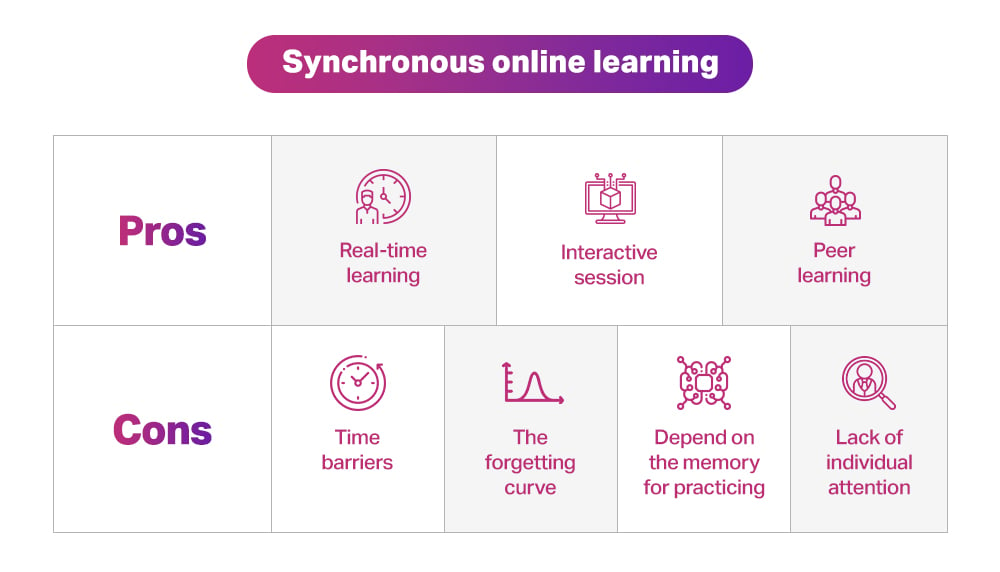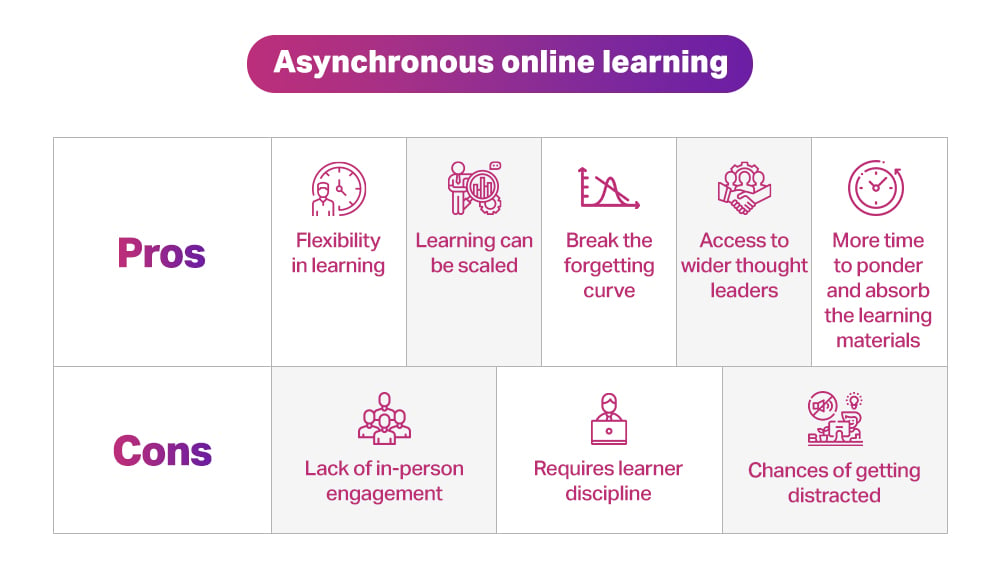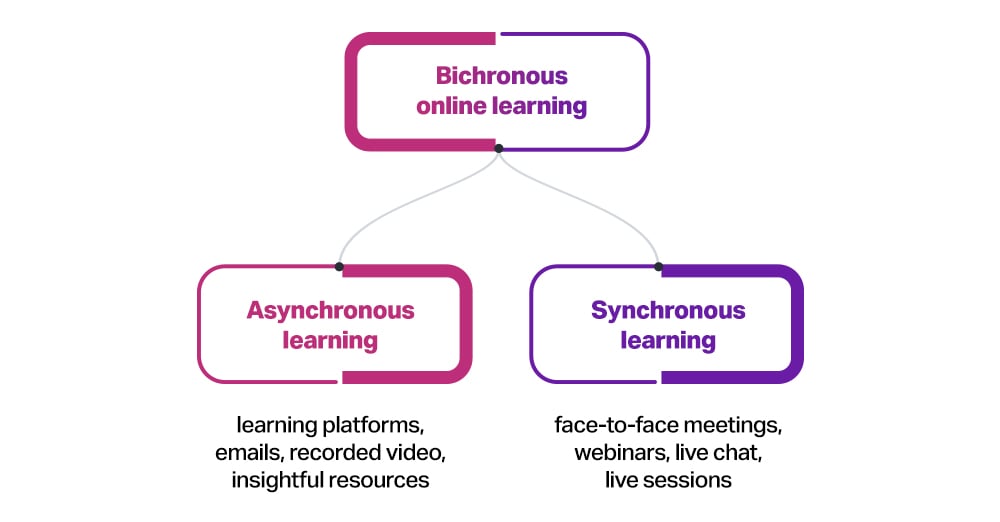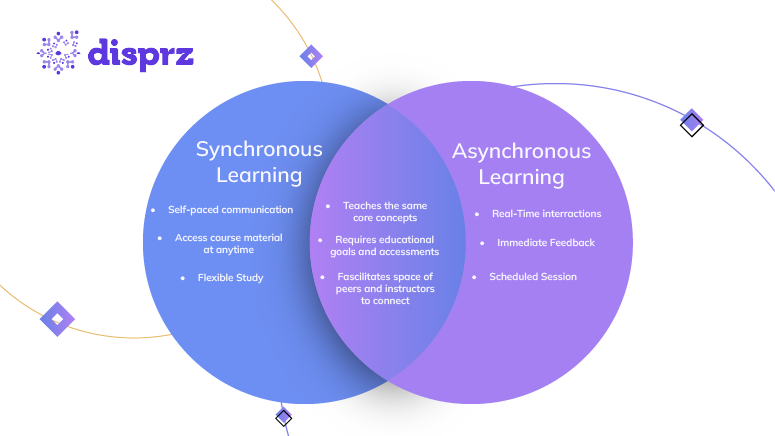Did you know that 93% of employees want easy-to-complete training, and 85% of employees want to choose training times that fit their schedules?
With digital acceleration and surging trends like on-the-job training and just-in-time learning, you might have thought the debate between asynchronous vs synchronous learning is settled.
We wish enterprise learning was that simple; unfortunately, it gets overly complicated with the advancements in the L&D domain. Research and opinions of L&D experts are still split between the two learning approaches due to concerns regarding learner engagement.
Are you wondering whether to play it safe by sticking to the conventional way of learning or giving employees the freedom to learn at their own pace? Before making your decision, explore synchronous vs asynchronous learning.
What is Synchronous Learning?
Synchronous learning is the learning method passed on for ages that echoes face-to-face interaction, whether in a virtual or traditional classroom. In a synchronous learning style, there are multiple people learning the same thing at the same time and the knowledge transfer happens in real time. So there is a space filled with synchronous discussions and opinions flowing.
In synchronous learning, the L&D professionals need to plan and deliver sessions that fit into pre-decided schedules. However, ensuring the busy employees make time for the training session is a tedious task. Most employees forcefully attend the sessions but are either distracted or forget most of the information by the time they get back to work.
Before the adoption of edTech, synchronous learning was the reigning king. The pandemic indeed propelled everyone to push their limits, and L&D professionals were no exception. They are forced to rethink their learning approaches to unlock the full potential of the employees.
The Pros & Cons of Synchronous Learning

Before you can truly appreciate the differences of synchronous vs asynchronous learning, you must understand the pros and cons of each. Let’s look at synchronous learning’s pros and cons through an example –
Pros
-
Real-time learning – The employee can witness tactics to address challenging situations in real-time
-
Interactive session – The L&D professional can test the customer support team’s knowledge by asking questions to make the learning environment interesting.
-
Peer learning
– The CS team can discuss what they’ve learned post-session and help each other with unclear concepts
Cons
-
Time barriers – L&D professionals have to block time from their busy schedules and ensure the entire CS team is available at the same time. With continuous client calls, it is sometimes difficult to schedule training sessions at a time that is convenient for all.
-
The forgetting curve– Once they get out of the training room, they forget some smart shortcuts that the L&D personnel projected on the screen to highlight the USP of the software.
-
Depends on memory for practicing– The residents do not have information in front of them while they are using the software themselves. They have to rely on their memory and later connect with the L&D professional, which hampers their practice session.
-
Lack of individual attention – Mere L&D-driven sessions are not enough as each employee absorbs knowledge and learns at a different pace. This is why a personalized learning plan, along with instructor-led training, is crucial to address individual knowledge gaps.
Examples of Synchronous Learning
Virtual classrooms
Real-time video lessons where students engage using chat and reactions, fostering social connection and attentiveness.
Webinars
Occur at set times with instructors presenting, and students interact via chat or live Q&A, often recorded for later review. They offer an engaging platform for in-depth exploration of complex topics in university lectures and professional training sessions.
Online conferences or summits
Feature expert instructors delivering a series of virtual lectures, offering in-depth coverage of complex topics over hours or days. These events are valuable for comprehensive learning or presenting related topics efficiently.
What is Asynchronous Learning?
Asynchronous learning gives employees the convenience of accessing learning programs at their preferred time. There are often due dates attached to the learning programs. However, employees get the freedom to choose when and where they want to access the resources shared by the instructors for self-paced learning. For instance, during the break, while commuting, or during the weekends.
Employees can easily balance remote learning with work in an asynchronous course.
However, the main challenge here is engaging the employees. In the absence of an instructor, there are chances that the employees might not engage with the learning material if the courses are not interesting.
Moreover, they need to see the value of investing their precious time in learning and development. Hence the asynchronous learning needs to be strategically planned by the L&D professional. So it is crucial to adopt the right learning technology, create an effective content strategy, present the content in the right format, and make the learning courses compelling to ensure employees engage with them.
The Pros & Cons of Asynchronous Learning

As we further explore synchronous vs asynchronous learning, we must learn the pros and cons of asynchronous learning. Let’s look at an example of training in the banking industry, where the policies, norms, interest rates, and client expectations are constantly changing.
Pros
-
Flexibility in learning – With asynchronous learning employees can learn at their own pace. They do need to attend a training session with others at a pre-decided time.
-
Learning can be scaled – The L&D professional can reuse the same training material to onboard the new employees instead of creating new material from scratch.
-
Break the forgetting curve – As per research, within one hour, people forget an average of 50 percent of the information presented. Within 24 hours, an average of 70 percent of new information is forgotten.
-
Access to wider thought leaders – The L&D professional can curate resources developed by various influencers and experts, so the employees get to learn from different experts rather than being confined to one instructor.
- More time to ponder and absorb the learning material – Employees can revisit the resources till they grasp how to perform the new skills effectively.
Cons
-
Lack of in-person engagement – Employees can’t directly get their queries resolved when they’re stuck while learning
-
Requires learner discipline – Since it is asynchronous, employees must exhibit self-discipline in learning regularly.
-
Chances of getting distracted – If the learning activities aren’t interesting, employees might get distracted. As per research, 50% of employees say that they are distracted by their phones at work
Synchronous vs Asynchronous Learning: Embracing a Blended Learning Approach

Synchronous and asynchronous learning are both powerful methods for delivering learning and development. However, when comparing synchronous vs asynchronous learning, both methods have a specific place and purpose.
Instead of focusing on the difference between synchronous and asynchronous learning, blend the two approaches to Bichronous learning to help improve L&D outcomes.
Leverage an LXP to blend Synchronous and Asynchronous Learning
Now that you have a clear understanding of synchronous vs asynchronous learning, you must determine how to effectively deliver employee learning for your organization. Using an advanced upskilling platform, like an LXP, enables you to easily offer a Bichronous learning style opportunity to your employees.
Disprz, a complete skilling suite, offers you a smartly designed Learning Experience Platform (LXP) that enables you to create synchronous learning through classroom and live sessions. You can personalize the entire asynchronous learning experience with this AI-powered learning platform. It helps you identify trending skills for each role and evaluate proficiency level for each skill through the manager, self, and peer assessment.
You can ensure consistent skill-building as it auto-creates personalized journeys from a content repository mapped to different skills.
Explore the Disprz LXP today to find out how it can help you drive result-driven Bichronous learning to empower your employees with the right skills and make them future-ready.









